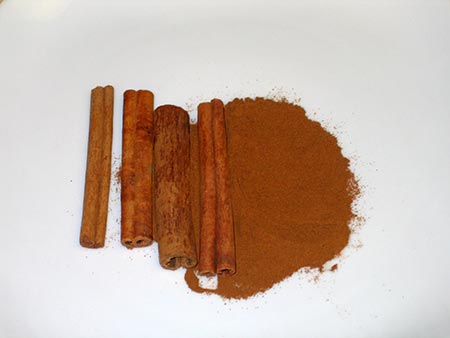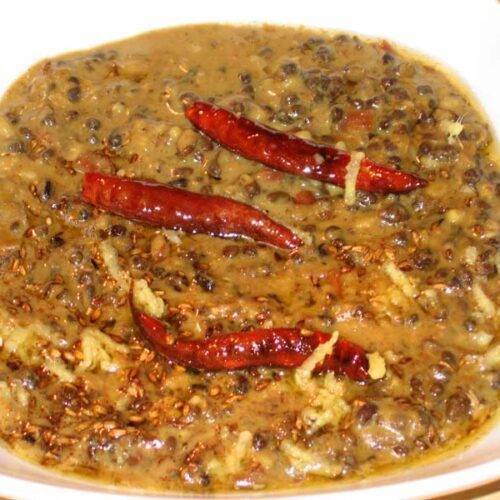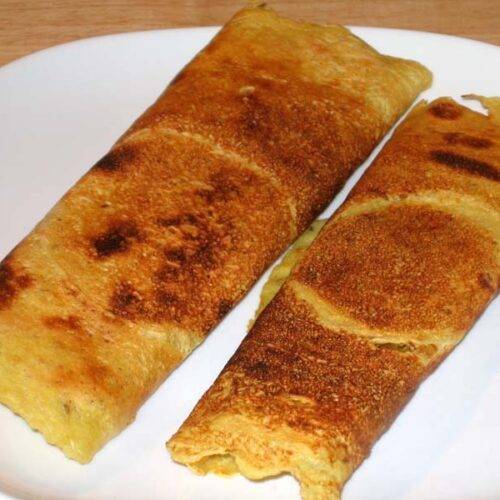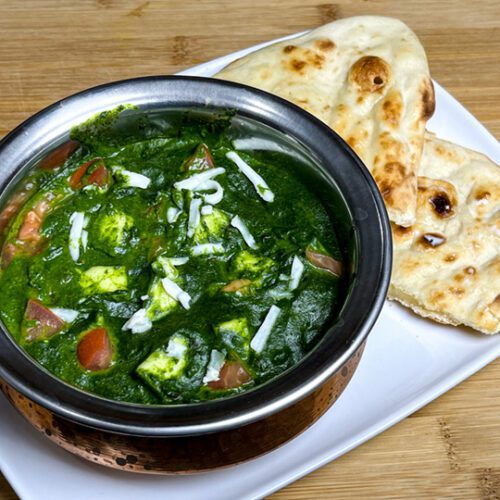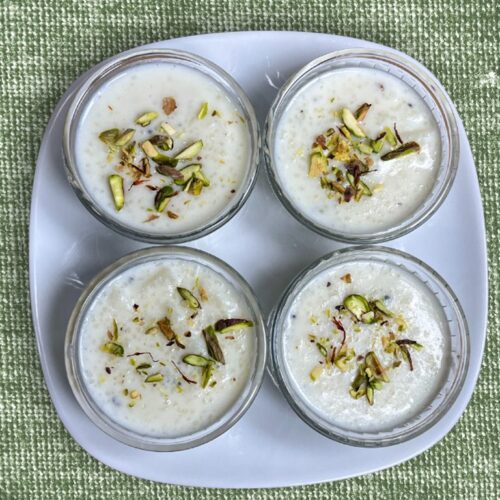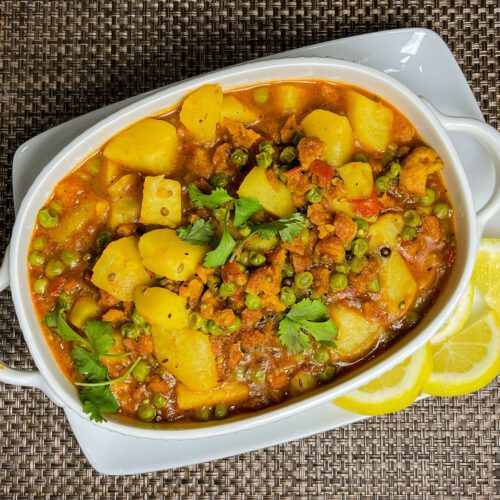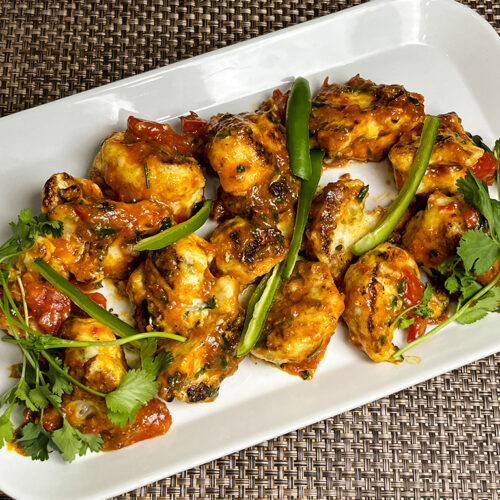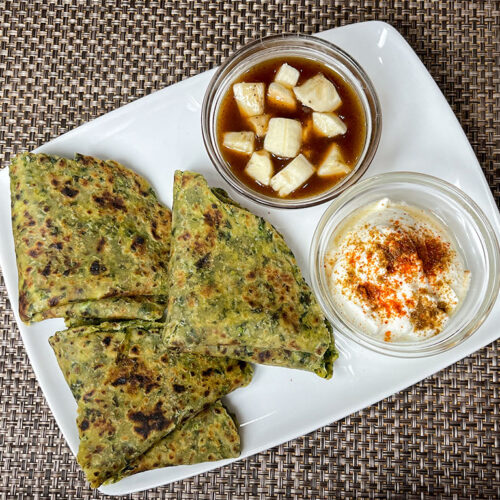The sweet aroma and warm taste of cinnamon make very unique spice for cooking or baking. Cinnamon has a unique anti-clotting action and is used to control blood sugar.
Search results for: “dal”
-
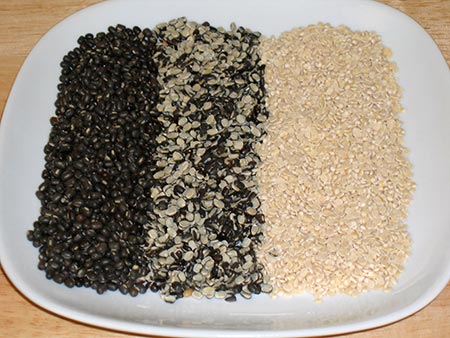
Urad dal
There are three types of Urad Dal:
- Whole urad
- split black urad with skin
- and split washed white urad
Urad dal has black skin, while the inside is creamy white. This white lentil is rich in protein and the iron content is good for improving hemoglobin count. Urad dal is great for vegan and low fat diets.
-
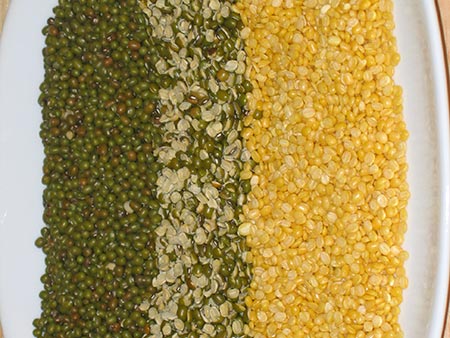
Moong Dal
There are three types of Moong Dal:
- Whole moong
- split green moong with skin
- split washed yellow moong
Moong dal is rich in protein and used in a variety of traditional vegetable dishes. They have a nutty flavor and are easy to cook. Moong is relatively easy to digest.
-
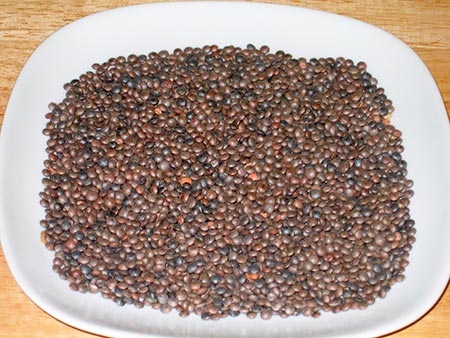
Masoor dal (lentils)
Lentils are dark brown to greenish brown in color, and a good source of iron and protein. Lentils also contain dietary fiber, vitamin B1, and minerals.
-
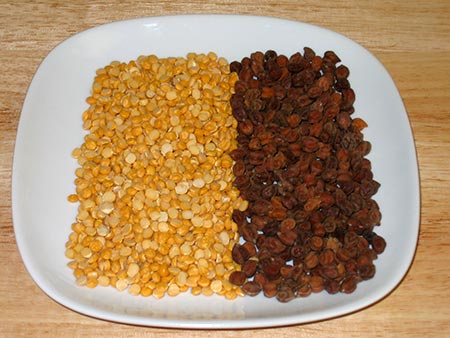
Chana Dal
Also known as Bengal Gram. This is the most popular legume in India. Chana dal has a very low glycemic index.
Whole Chana Dal
Whole chana is known as kala chana and belongs to the same family as chickpea. Whole chana is a little smaller and darker brown than chickpea and has a nutty taste. Kala chana is high in iron and protein.
Split Chana Dal
Without the skin and split, chana is known split chana dal. Flour from chana dal is called Basen. Chana dal is delicious, nutritious and easily digested.
-
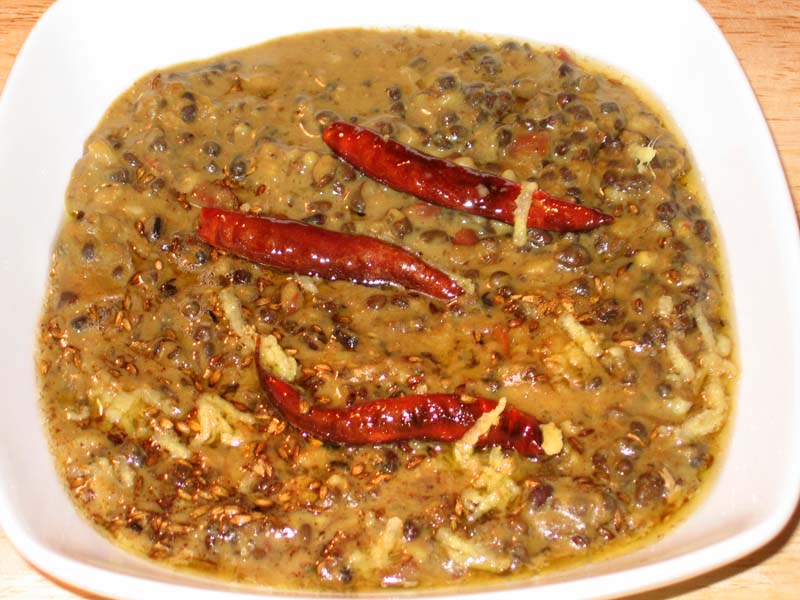
Dal Makhani
Dal Makhani, Punjabi Style
Dal Makhani is a popular dish from state of Punjab and across North India. Rich and hearty, dal makhani is a combination of whole urad (an Indian lentil)and red kidney beans. It goes well with Naan, and Tandoori Roti (oven-baked flat bread).Ingredients
- 1/2 cup whole urad dal
- 1/8 cup red kidney beans rajma
- 1 tsp ginger grated
- 1 green chili, finely chopped
- 1/2 tsp turmeric haldi
- 3/4 tsp salt
- 1/2 tsp mango powder amchoor
- 1/4 tsp garam masala
- 1/4 cup cream
For Seasoning
- 2 tbsp ghee, clarified ghee
- 1/2 tsp cumin seeds jeera
- 1/8 tsp asafetida hing
- 3 whole dried red chilies
- 1/4 tsp red chili powder
- 1/2 tbsp ginger thinly sliced
Instructions
- Wash urad dal and kidney beans well. Soak the dal in six cups of water at least for eight hours. After soaking, dal will be about two and a half times the volume of the original.
- Place the dal in a pressure cooker with four cups of water. Add the salt, turmeric, ginger, and green chili, and cook over medium high heat. When it begins to steam, turn the heat down to medium. Cook 25 minutes.
- Turn off the heat. Wait until steam has stopped before opening the pressure cooker. The dal and kidney beans should be soft and tender.
- Lightly mash the kidney beans and dal. Cook for another five minutes on low-to-medium heat.
- Add cream, garam masala, and amchoor powder. Cook for ten minutes on low heat.
For Seasoning
- Heat the ghee in a small saucepan. Test the heat by adding one cumin seed to the oil; if it cracks right away, the oil is ready. Add cumin seeds. When they crack, add the asafetida, red chilies, and red chili powder. Stir for a few seconds.
- Add one teaspoon of water to keep the spices from burning. Pour the spiced ghee over the dal.
- Garnish with shredded ginger.
Notes
Serving suggestion, taste best with Naan, or Tandoori RotiTried this recipe?Let us know how it was!Punjabi Dal Makhani: A Step by Step Urad Dal Makhani Recipe
Dal Makhani is a rich and creamy lentil dish that originates from the Punjab region of India. Made with black lentils (urad dal), kidney beans, and a blend of aromatic spices, this dal makhani recipe is a staple in Punjabi cuisine. Known for its luscious texture and indulgent flavors, Dal Makhani is a popular Indian dish made primarily from lentils (dal) and typically enjoyed during the winter months.
It is a rich and creamy dish that is usually gluten-free, as lentils themselves are naturally gluten-free. The main ingredients for making Dal Makhani include black lentils (urad dal), red kidney beans (rajma), butter, cream, and various spices such as cumin, coriander, turmeric, and garam masala. It is traditionally cooked slowly over a low flame, allowing the flavors to meld together and the lentils to become tender. Dal Makhani is often served with rice or Indian bread like naan or roti.
Step 1: Preparation of Ingredients:
Begin by gathering all the necessary ingredients for making Dal Makhani. Rinse the black lentils and kidney beans under cold water and soak them for at least 8 hours or overnight to soften. Finely chop tomatoes, ginger, and green chilies to prepare the base for the dal. Having all the ingredients prepped and ready will make the cooking process smoother.
Step 2: Cooking the Lentils:
In a pressure cooker or a pot, add the soaked black lentils and kidney beans along with fresh water, salt, and a pinch of turmeric powder. Pressure cook or simmer until the lentils and beans are soft and fully cooked. Cooking them until tender is essential for achieving the creamy texture of Dal Makhani. Once cooked, set them aside while we prepare the gravy.
Step 3: Preparing the Gravy:
In a large pot or saucepan, heat oil or ghee over medium heat. Add whole spices such as cinnamon, cloves, and cardamom pods, and let them sizzle. Then, add finely chopped ginger and green chilies, and sauté until fragrant. The aromatic base will infuse the gravy with depth of flavor.
Step 4: Adding Tomatoes:
Once the aromatics are sautéed, it’s time to add the chopped tomatoes to the pot. Cook the tomatoes until they soften and break down, forming a thick gravy. You can also add tomato puree for a smoother texture. Stir in spices such as coriander powder, cumin powder, red chili powder, and garam masala, and cook until the oil separates from the mixture.
Step 5: Cooking the Lentils with Gravy:
Now, add the cooked black lentils and kidney beans to the pot with the tomato gravy. Stir well to combine all the ingredients. Allow the mixture to simmer for a while, allowing the flavors to meld together. This slow cooking process helps develop the rich and indulgent flavors of Dal Makhani.
Step 6: Adding Cream and Butter:
To finish off the dish, add a generous amount of cream and butter to the pot. Stir well to incorporate the cream and butter into the dal, creating a velvety and luxurious texture. Adjust the seasoning with salt and add a pinch of sugar to balance the acidity of the tomatoes if needed.
Step 7: Garnishing and Serving:
Before serving, garnish the Dal Makhani with freshly chopped cilantro leaves for a burst of freshness and color. You can also drizzle a little more cream on top for added richness. Serve the Dal Makhani hot with steamed rice, naan, or roti for a comforting and satisfying meal.
Tips for Making Perfect Dal Makhani:
- Soak Lentils and Beans: Soaking the black lentils and kidney beans overnight helps reduce cooking time and ensures they cook evenly.
- Slow Cooking: Allow the dal to simmer on low heat for a longer time to develop the flavors and achieve the desired creamy consistency.
- Use Fresh Cream and Butter: Using fresh cream and butter adds richness and depth of flavor to the dish.
Variations of Dal Makhani:
- Spicy Dal Makhani: Add extra green chilies or red chili powder for a spicier version of the dish.
- Restaurant-style Dal Makhani: For a restaurant-style flavor, add a tadka (tempering) of cumin seeds and dried red chilies in ghee and pour it over the prepared dal before serving.
Benefits of Including Dal Makhani in Your Diet:
- High in Protein: Dal Makhani is rich in protein from black lentils and kidney beans, making it a nutritious option for vegetarians and vegans.
- Rich in Iron: Black lentils are a good source of iron, which is essential for maintaining healthy blood cells and preventing anemia.
- Source of Healthy Fats: The addition of cream and butter provides healthy fats, which are important for overall health and satiety.
Frequently Asked Questions (FAQs) about Dal Makhani:
Q: Can I make Dal Makhani in advance?
A: Yes, Dal Makhani tastes even better when made in advance as it allows the flavors to develop. It can be stored in the refrigerator for up to 3-4 days and reheated before serving.
Q: Can I freeze Dal Makhani?
A: Yes, Dal Makhani freezes well. Allow it to cool completely, then transfer it to airtight containers or freezer bags and freeze for up to 3 months. Thaw overnight in the refrigerator before reheating.
Q: Is Dal Makhani gluten-free?
A: Yes, Dal Makhani is naturally gluten-free, making it suitable for those with gluten intolerance or celiac disease.
For more delicious Indian dal recipes, visit Manjula’s Kitchen. Explore a variety of vegetarian dal dishes featuring a range of lentils, spices, and vegetables to add flavor and variety to your meals.
For more delicious Indian recipes, check out Manjula’s Kitchen: Chole Bhature, Naan, Paneer Tikka Masala, Aloo Paratha, Vegetable Biryani.
-
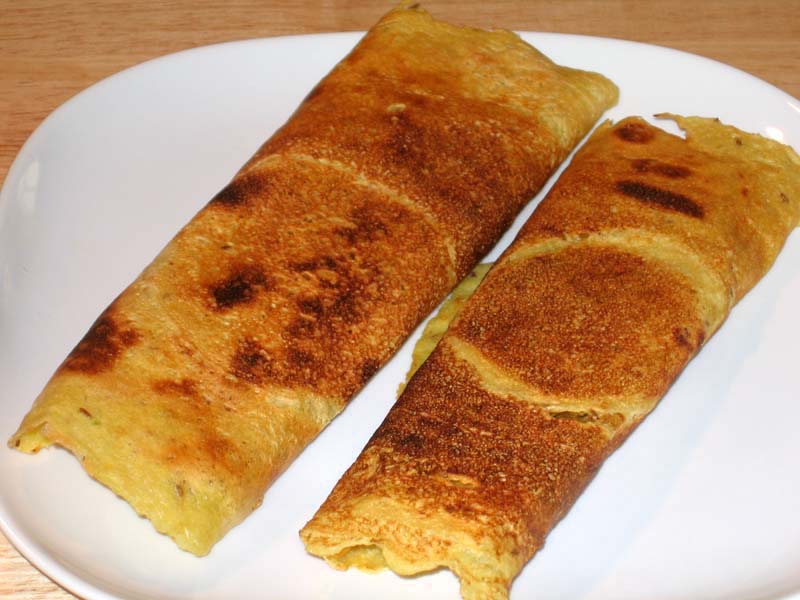
Moong Dal Dosa
Moong Dal Dosa, Cheela
Moong Dal Dosa, also known as “cheela” or “puda, is a thin, crisp pancake made from any one of a variety of batters. Moong dal dosa is a convenient substitute, quick & easy to prepare than the traditional dosa. Traditional dosas are made with fermented urad dal and rice.Ingredients
- 1 cup washed moong dal
- 1 chopped green chili
- 1/4 inch piece of ginger chopped
- 1/2 tsp cumin seeds
- 1/2 tsp salt
- 6 tbsp oil
Instructions
- Wash the dal, changing the water several times until it appears clear. Soak dal in four cups of water for at least four hours.
- Drain the water. Blend the dal with green chile and ginger, adding water slowly as needed to make a smooth batter. Note: The less water, the smoother the batter.
- Mix the salt and cumin seeds into the batter. Add water as needed. The total water added will be about ½ cup, just enough to achieve the consistency of pancake batter.
- Place a non-stick- skillet over medium-high heat. Test by sprinkling a few drops of water on it. The water should sizzle right away.
- Pour ½ cup of the batter mixture into the skillet and spread evenly with the back of a spoon. Starting from the center, spiral outward until evenly spread, about seven inches in diameter.
- When the batter begins to dry, gently spread one teaspoon of oil over it. Wait about 30 seconds, then flip the puda using a flat spatula.
- Press the dosa lightly with the spatula all around to assure even cooking, turning them two to three times. Dosa should be crisp and golden brown on both sides.Repeat for the remaining dosas.
Notes
Serving suggestion: Serve dosa folded with Aloo Masala For Dosa or Jeera Aloo you can fold with your favorite cheese. You can also serve with Samber or with yogurt.Tried this recipe?Let us know how it was!Learn How To Make Moong Dal Dosa With Moong Dal – Manjula’s Kitchen
Dosa is a popular south indian delicacy which looks like a crepe. It’s like a crisp and thin pancake made of rice and urad dal batter. Traditionally Dosa is served with sambar, aloo masala and coconut chutney. It is an Indian crepe made usually through rice batter, but here we have experimented and made many alternative dosa such as Oat Dosa, Besan Dosa, Rava Dosa, Sorghum Dosa, whole wheat dosa. This preparation is using moong dal and is a bread based gluten free breakfast recipe that is vegan. The preparation entails skillfully combining pan techniques and manual dexterity to achieve the perfect bread cooked on non-stick skillets.
Preparing Moong Dal:
Embarking on the enticing journey of crafting moong dal dosa, initiate by meticulously washing the moong dal, repeating the water-changing ritual to ensure absolute clarity. Immerse the dal in four cups of water, allowing it to soak for a minimum of four hours, cultivating a soft and pliable texture essential for the success of this revered moong dal dosa recipe. The thorough soaking not only aids in the dosa’s consistency but also serves as a testament to the meticulousness ingrained in the recipes of moong dal dosa.
Blending Moong Dal Batter:
Upon draining the soaked moong dal, transition to the blending phase, where precision is key. Combine the dal with green chile and ginger, gradually introducing water to achieve a seamlessly smooth batter. Be mindful that the proportion of water directly impacts the final texture, a crucial detail in the nuanced art of dosa recipe with moong dal. This harmonious blending process transforms the moong dal into a versatile canvas, ready to absorb the flavours and nuances that define this iconic dish.
Seasoning the Batter:
Elevate the moong dal batter to a symphony of flavours by introducing salt and cumin seeds. Adjust the water content with care, ensuring the batter attains the consistency reminiscent of pancake batter, a vital characteristic in the sought-after recipes of moong dal dosa. This seasoning process not only imparts depth to the batter but also plays a pivotal role in shaping the distinct taste profile that defines moong dal dosa recipe.
Heating the Skillet:
Transitioning to the cooking phase, heat a non-stick skillet over medium-high heat, a critical step in the dosa-making process. The sizzle of water droplets confirms the skillet’s readiness, setting the stage for the dosa’s journey from batter to a crisp delicacy. This well-calibrated heat not only ensures the dosa’s optimum texture but also encapsulates the essence of precision embedded in the moong dal dosa recipe.
Pouring and Spreading the Batter:
With the skillet primed, gracefully pour ½ cup of the moong dal batter onto the heated surface. Employing the back of a spoon, skillfully spread the batter in a spiral motion, originating from the centre and expanding to a symmetrical seven-inch diameter. This meticulous spreading ritual is not merely a technicality but an artful dance that defines the visual appeal and thickness of the moong dal dosa, showcasing the intricacies of dosa recipe with moong dal.
Cooking and Flipping the Dosa:
As the batter begins to dry, introduce a teaspoon of oil, spreading it delicately over the dosa’s surface. After a brief interlude, execute a precise flip using a flat spatula, revealing the golden-brown underside. Gently press the dosa to ensure uniform cooking, turning it two to three times. This vigilant cooking process guarantees a crisp finish and a tantalising aroma, embodying the essence of moong dal dosa recipe.
Repeating the Dosa-Making Ritual:
The final act involves replicating the dosa-making ritual for the remaining batter, ensuring a consistent outcome. Reiterate the process of pouring, spreading, cooking, and flipping until each moong dal dosa mirrors the perfection achieved in the initial creation. This dedicated repetition encapsulates the spirit of tradition and craftsmanship ingrained in the recipes of moong dal dosa, culminating in a batch of savoury, golden delights awaiting appreciation in all their flavorful glory.
-
Category List
With over 19 years of videos produced we can’t list them all here. Here are some of the main categories:
If you’re looking for a particular recipe visit our search page.
If you’d like to see all the categories, they are listed here.
-
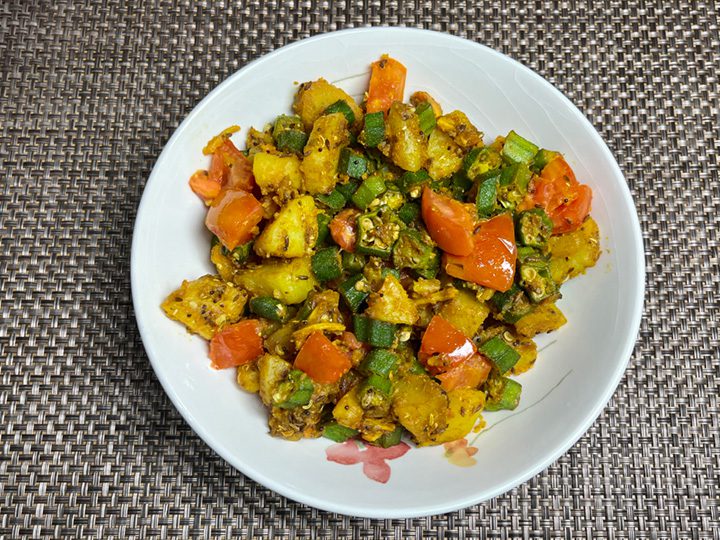
Aloo Bhindi Masala
Aloo Bhindi Masala
Aloo Bhindi is a popular dish in my home, a simple yet flavorful North Indian stir-fry made with potatoes (aloo) and okra (bhindi). This vegan and gluten-free dish is spiced just right, making it a crowd-pleaser for everyone at the table.I always find that home-cooked meals are more flavorful, fresh, and nourishing, and this Aloo Bhindi is no exception. It’s quick to prepare, using everyday ingredients, and the balance of spices brings out the natural flavors of the vegetables. Adding tomatoes at the end not only enhances the taste but also makes the dish vibrant and visually appealing.I always find that home-cooked meals are more flavorful, fresh, and nourishing, and this Aloo Bhindi is no exception. I like to serve Aloo Bhindi with dal, rice, and roti, creating a balanced and enjoyable meal.Ingredients
- 1½ cup chopped okra
- 1½ cup cubed boiled potatoes same size as okra
- 3 tbsp oil divided
- ¼ tsp mustard seed
- 1 tsp cumin seeds
- ⅛ tsp asafetida
- 2 tbsp tbsp
- ½ tsp turmeric
- 1 tbsp ginger thinly sliced
- 2 tsp salt adjust to taste
- ½ tsp red chili powder adjusts to taste
- 2 tbsp Besan
- ½ cup cubed tomatoes
Instructions
- Wash the okra thoroughly and ensure it is completely dry. Cut the okra into ½ inch rounds.
- Boil the potatoes, ensuring they are not overcooked. Peel them and cut them into pieces about twice the size of the okra.
- Chop the tomatoes into pieces about the same size as the potatoes.
- Heat 1 tablespoon of oil in a saucepan over low heat. Add the okra and stir-fry for about 5 minutes, until tender but still green. Remove the okra from the pan and set aside.
- In the same pan, add 1 tablespoon of oil. Heat the oil until moderately hot and test the heat by adding a single cumin seed. If the seed cracks right away, the oil is ready. Add cumin seeds, mustard seeds, and asafetida. Stir, then add the potatoes and ginger, stirring for 2-3 minutes.
- Stir in the spices: coriander powder, turmeric, and chili powder. Add the okra back into the pan, sprinkle with besan (gram flour) and salt. The besan helps the spices coat the okra and potatoes. Cook for 2-3 minutes over low heat.
- Once the okra and potatoes are cooked through, add the chopped tomatoes and stir for a few more minutes until combined. Adding tomatoes at the end not only enhances the taste but also makes the dish vibrant and visually appealing. The Potato Okra Masala is ready and looks vibrant and colorful.
Notes
Thanks, and enjoy!Tried this recipe?Let us know how it was!Aloo Bhindi Masala (Potato Okra): A Flavorful North Indian Stir-Fry | Manjula’s Kitchen
Introduction to Aloo Bhindi Masala
Aloo Bhindi, a delicious combination of potatoes (aloo) and okra (bhindi), is a beloved North Indian stir-fry that’s both vegan and gluten-free. This dish is spiced to perfection, with everyday ingredients that enhance the natural flavors of the vegetables. It’s a simple, quick, and nutritious meal that’s perfect for any day of the week. With tender okra, perfectly boiled potatoes, and a blend of spices, Aloo Bhindi makes a great accompaniment to dal, rice, or roti.
Cultural and Traditional Importance
Aloo Bhindi is a common dish in many North Indian households. Its simplicity and ease of preparation make it a staple for busy weeknights, while its flavorful spices and colorful presentation make it special enough for family gatherings. In India, meals often feature a variety of dishes to balance textures and flavors, and Aloo Bhindi is frequently paired with lentils like Dal Tadka and breads like Roti for a wholesome and complete meal.
Cooking Aloo Bhindi at home not only allows for fresher ingredients but also ensures that the dish is prepared exactly to your taste. With the addition of besan (gram flour) and tomatoes, this dish becomes both hearty and vibrant, appealing to everyone at the table.
Recipe Variations from Manjula’s Kitchen
While Aloo Bhindi Masala is a popular dish on its own, you can explore other similar stir-fry recipes or variations with different vegetables from Manjula’s Kitchen:
- Aloo Gobi: A stir-fry made with potatoes and cauliflower, flavored with similar spices, making it a close cousin to Aloo Bhindi.
- Bhindi Masala: A more saucy version of okra, cooked in a spiced tomato gravy, offering a different take on okra dishes.
- Aloo Baingan: A tasty variation that combines potatoes with eggplant, cooked in a similar blend of spices.
- Baingan Bharta: A roasted eggplant dish that pairs well with Aloo Bhindi as part of a larger spread.
Health Benefits and Dietary Considerations
Aloo Bhindi is not only flavorful but also packed with nutrients. Okra is rich in vitamins A and C, fiber, and antioxidants, while potatoes provide potassium and carbohydrates, making this dish a great source of energy. The use of minimal oil and the addition of spices like cumin, coriander, and turmeric add both flavor and health benefits, with turmeric known for its anti-inflammatory properties.
This recipe is naturally gluten-free and vegan, making it suitable for a variety of dietary needs. For a lower-carb option, you can reduce the amount of potatoes or substitute them with sweet potatoes or other root vegetables. Besan (gram flour) adds a touch of protein and helps the spices adhere to the vegetables, making the dish even more satisfying.
Serving Suggestions
Masala Aloo Bhindi can be enjoyed as a side dish or as the main course. It pairs perfectly with Indian breads like roti, paratha, or even naan. For a more complete meal, serve it alongside Jeera Rice and a cooling yogurt dish like Raita.
If you’re hosting a meal, Aloo Bhindi Masala makes a colorful addition to the table when paired with other Indian classics like Chole or Dal Fry. The vibrant colors and bold flavors of these dishes create a well-balanced and satisfying meal that’s sure to impress.
Conclusion
Aloo Bhindi Masala is a simple, flavorful, and nutritious dish that can be prepared quickly with everyday ingredients. Its combination of tender potatoes, crisp okra, and aromatic spices makes it a versatile meal option that’s both comforting and satisfying. Whether you’re serving it as part of a traditional Indian meal or enjoying it as a standalone dish, Aloo Bhindi is sure to become a favorite in your home. Try this recipe today and bring the taste of North Indian home cooking to your kitchen.
Frequently Asked Questions (FAQs)
- How can I prevent okra from becoming slimy?
- To prevent sliminess, make sure the okra is thoroughly dry before cooking. Frying the okra over low heat without covering the pan also helps to keep the texture crisp.
- Can I substitute potatoes with another vegetable in this recipe?
- Yes, you can substitute potatoes with sweet potatoes, carrots, or even eggplant for a different take on the dish.
- What are some variations of Aloo Bhindi I can try?
- You can try Aloo Gobi or Bhindi Masala for similar stir-fried dishes that use different vegetables or a saucy variation.
- How should I serve Aloo Bhindi?
- Masala Aloo Bhindi pairs wonderfully with roti, paratha, or naan. It can also be served with rice and a cooling raita for a complete meal.
- Is this dish suitable for vegans and those on a gluten-free diet?
- Yes, Aloo Bhindi is naturally vegan and gluten-free, making it a great choice for those with dietary restrictions.
-
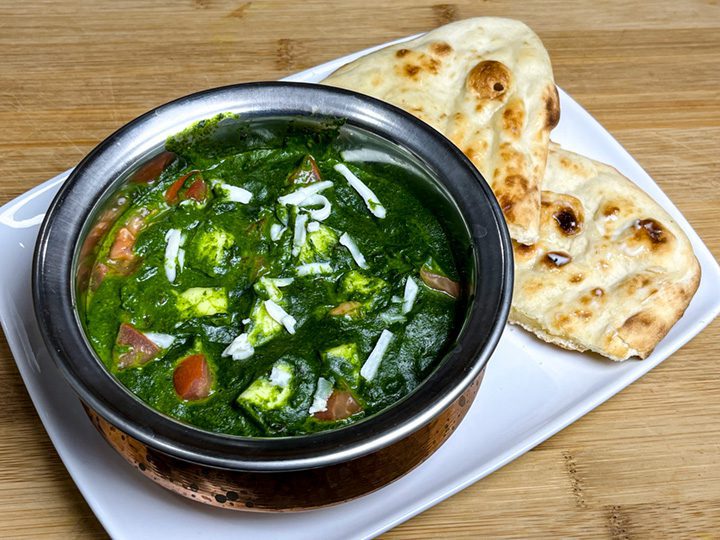
Palak Paneer
Palak Paneer
Palak Paneer is perhaps the most popular paneer dish in North India and is a favorite in Indian restaurants. Creamy spinach paired with paneer makes for a delicious main course. This recipe has always been one of my favorites, and I can prepare it quickly. Although I’ve made this recipe before, I now want to simplify it by using just a few ingredients. Even after so many years of cooking, I’m still learning and striving to keep things simple, healthy, nutritious, and flavorful. This dish is made with blanched spinach, which helps retain its vibrant green color. I didn’t know why blanching was used in cooking, but this is all part of the learning process. Palak Paneer pairs perfectly with roti, naan, or paratha.Ingredients
- 5 oz spinach washed and clean, about 6 cups packed spinach
- 1 cup paneer cubed into bite size, about 4oz of paneer
- 1 green chili chopped
- 1 tbsp oil
- 1/2 tsp cumin seeds – jeera
- 1/8 tsp asafetida – hing
- 1 tsp coriander powder – dhania
- 1/4 tsp turmeric – haldi
- 1/2 tsp salt adjust to taste
- 1/2 tsp sugar
- 1 tbsp whole wheat flour
- 1/4 cup heavy cream
- 1/4 cup finely chopped tomato
- 2 tbsp paneer shredded for garnishing
Instructions
- First blanch the spinach, this helps to keep the spinach color bright. To blanch the spinach, boil about 6 cups of water in a saucepan, and let the spinach boil for one minute. Drain the water and put the spinach in ice cold water for about two minutes. Drain the water.
- Blend the spinach, ginger and green chili. Spinach should be creamy.
- Soak the cubed paneer in about three cups of hot water, for about 5 minutes. This helps to give the paneer a soft texture. Set it aside.
- While cooking, spinach can splatter, use larger saucepan. Heat the oil in a saucepan, over medium high heat. Test the heat by adding one cumin seed to the oil; if it cracks right away it is ready.
- Add cumin seed, and asafetida. After cumin seeds crack, add blended spinach and stir. Add coriander, salt, and sugar, stir.
- After spinach comes to boil lower the heat to low, and let the spinach cook for about 5-6 minutes partially cover the pot, because spinach will splatter. I don’t cover the pan fully because this helps keep the green color of spinach.
- Mix the flour to 1/2 cup of water and add to the spinach, also add the cream. Mix it well and let it cook for five minutes. If needed add a little more water.
- Drain the paneer and fold it gently with spinach and let it simmer for about five minutes.
- Palak paneer is ready, add the tomatoes and turn off the heat. Garnish it with shredded or crumbled paneer.
Tried this recipe?Let us know how it was!Palak Paneer is one of the most popular paneer dishes from North India and a favorite at Indian restaurants around the world. This creamy, flavorful dish features tender paneer cubes nestled in a rich spinach sauce, making it a perfect main course for any meal.
With its vibrant green color and delicious combination of spinach and paneer, Palak Paneer pairs wonderfully with roti, naan, or paratha. This simplified version of the recipe uses just a few ingredients, allowing the natural flavors of the spinach and paneer to shine while remaining healthy and nutritious.
Cultural and Traditional Importance
Paneer dishes are a staple in North Indian cuisine, and Palak Paneer is undoubtedly one of the most beloved. Traditionally prepared in Indian households and served during special occasions or family gatherings, this dish showcases the versatility of paneer and the use of leafy greens in Indian cooking.
Palak Paneer is often served with flatbreads like naan or paratha, and its creamy texture and mildly spiced flavor make it a crowd-pleaser.
This simplified recipe doesn’t compromise on taste, while offering a more convenient way to prepare Palak Paneer at home. Blanching the spinach helps retain its bright green color, making the dish visually appealing as well as delicious.
Recipe Variations from Manjula’s Kitchen While Palak Paneer is a classic dish on its own, you can explore other paneer-based recipes and spinach variations from Manjula’s Kitchen:
Paneer Butter Masala: A rich and creamy tomato-based dish, perfect for those who enjoy a sweeter, milder flavor.
Aloo Palak (Potato Spinach): A delicious vegetarian dish combining spinach with tender potatoes, offering another way to enjoy spinach in your meals.
Paneer Saag: A similar dish that incorporates other leafy greens, like mustard greens, along with spinach for a different flavor profile.
Matar Paneer: A flavorful combination of paneer and green peas cooked in a spiced tomato sauce, offering a wonderful variation for paneer lovers.
Health Benefits and Dietary Considerations Palak Paneer is not only delicious but also packed with nutrients. Spinach is rich in iron, vitamins A, C, and K, as well as antioxidants that promote overall health.
The use of paneer adds a good amount of protein and calcium, making this dish a balanced meal that supports both muscle and bone health.
For those looking to make a lighter version of Palak Paneer, you can substitute the heavy cream with a lighter cream or yogurt. The dish is also naturally gluten-free (ensure the flour you use is gluten-free or omit it), making it suitable for those with gluten sensitivities. If you’re vegan, tofu can be used in place of paneer to create a delicious Palak Tofu.
Serving Suggestions Palak Paneer can be served with a variety of Indian breads, such as roti, naan, or paratha. It also pairs well with rice dishes like Jeera Rice or Plain Basmati Rice for a more complete meal. For added texture and flavor, you can garnish the dish with freshly grated paneer or a drizzle of cream.
For a more elaborate meal, serve Palak Paneer alongside other classic Indian dishes such as Dal Tadka or Aloo Gobi to create a balanced vegetarian spread.
Conclusion Palak Paneer is a quintessential North Indian dish that brings together the creamy richness of paneer and the nutritious goodness of spinach. This simplified recipe ensures that you can prepare this dish quickly, without sacrificing flavor or texture. Whether you’re cooking for a family dinner or hosting a special meal, Palak Paneer is sure to be a hit. Try this recipe today and enjoy one of India’s most loved dishes in the comfort of your home.
Frequently Asked Questions (FAQs)
How do I keep the spinach color bright in Palak Paneer?
Blanching the spinach is the key to retaining its vibrant green color. Boil the spinach for about a minute, then immediately transfer it to ice-cold water to stop the cooking process.
Can I make Palak Paneer vegan?
Yes, you can substitute the paneer with tofu and use coconut cream or cashew cream in place of dairy cream to make a vegan version of this dish.
What are some variations of Palak Paneer I can try?
You can try dishes like Saag Paneer, which uses a combination of leafy greens, or Aloo Palak, which pairs spinach with potatoes for a different take on the classic.
How do I serve Palak Paneer?
Palak Paneer pairs wonderfully with Indian breads like naan, roti, or paratha. It can also be served with Jeera Rice or Plain Basmati Rice.
Can I prepare Palak Paneer in advance?
Yes, you can prepare the spinach puree and paneer in advance. Store them separately in the refrigerator, and when ready to serve, gently reheat and combine the two for a fresh and delicious meal.
-
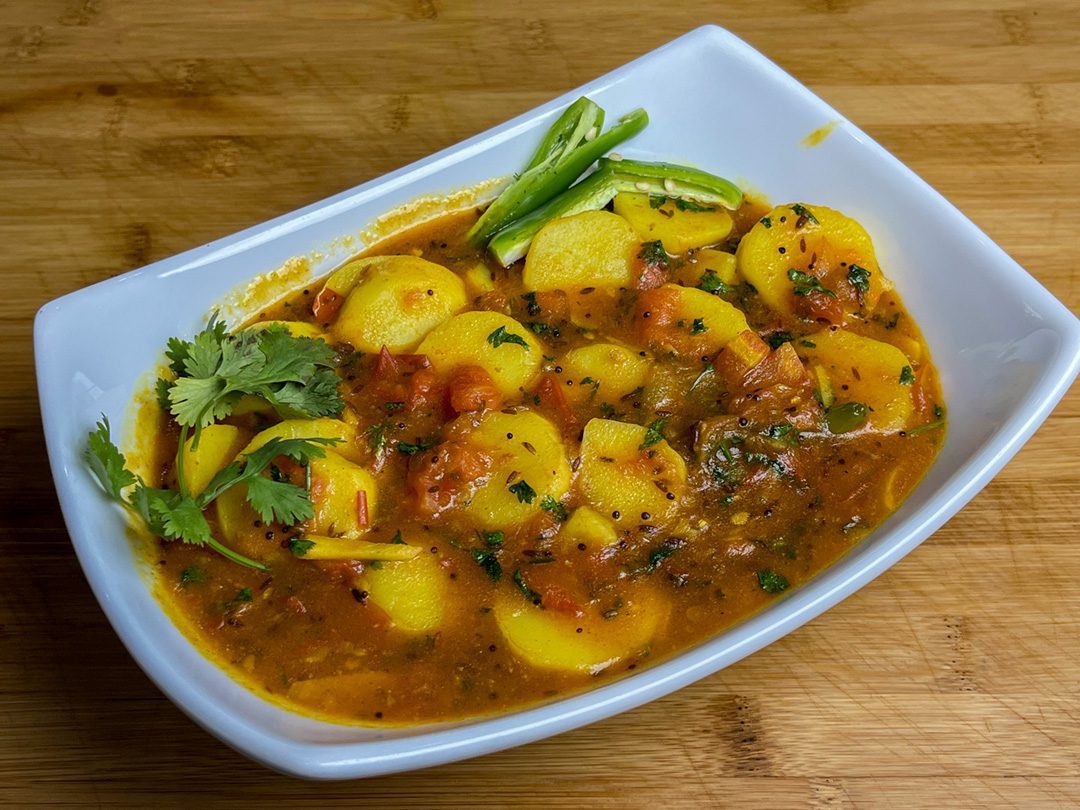
Sweet and Sour Potatoes
Sweet and Sour Potatoes
If you're looking for a dish that combines the perfect balance of sweetness, spiciness, and tanginess, this Sweet and Sour Potatoes recipe is just what you need. Tender potatoes cooked in a rich, spicy, and tangy tomato gravy create a flavor explosion in every bite!This dish features potatoes sliced into round disks, and smothered in a delicious tomato gravy. The gravy is a perfect blend of sweet, spicy, and sour, and it clings to each piece of potato, making every bite irresistible.What makes this recipe truly special is the way it balances different flavors. It’s a dish that is both comforting and exciting. Whether you're serving it as a main course or a side dish, I enjoy serving it over rice or with puri or paratha.I use small white potatoes because they hold their shape even when cooked to a soft and tender texture. These tender potato disks in tomato gravy make a gorgeous dish that's hard to resist.This is also delightful vegan and gluten-free dish.Ingredients
- 10 small, boiled baby potatoes also known Ukrainian potatoes
- 2 cups 3 medium tomatoes chopped
- 2 tbsp oil
- 1 tbsp ginger thinly sliced, adrak
- 2 green chili sliced long ways; seeds removed
- 1/8 tsp asafetida, hing
- 1 tsp cumin seed
- 1/2 tsp black mustard seed, rai
- 1/2 tsp red chili powder, lal mirch
- 1/2 tsp fennel seeds powder, saunf
- 2 tsp crushed coriander, dhania
- 1/2 tsp turmeric, haldi
- 1-1/2 tsp salt
- 2 tsp cornstarch
- 2-3 tbsp sugar, adjust to taste
- 2 tbsp chopped cilantro, hara dhania
Instructions
- Boil the potatoes until they are tender, then peel and slice them into quarter inch-thick round disks.
- Heat oil in a saucepan. Test the heat by adding a cumin seed; if it cracks, the oil is ready.
- Add black mustard seeds, cumin seeds, and asafetida. Once the seeds crackle, add red chili powder, coriander, fennel powder, and turmeric.
- Stir briefly, then add chopped tomatoes and green chilies. Let the mixture simmer for 2-3 minutes.
- Add the potato slices.
- Cover the pot and cook for about 10 minutes over medium-low heat. Add sugar and cilantro. If the gravy becomes too thick, add water as needed. Cover and let it sit for a few minutes.
- Adjust the salt and sugar to your taste.
Notes
Tip: Add sugar slowly, depending on the sourness of the tomatoes. You can omit the green chilies or remove their seeds if you prefer a milder flavor. What are Ukrainian potatoes? They are white and are also known as baby potatoes or new potatoes. Delicious Sweet and Sour Potatoes: A Very Colorful, Flavorful Dish Enjoy!Tried this recipe?Let us know how it was!Sweet and Sour Potatoes: A Flavorful Fusion | Manjula’s Kitchen
If you’re looking to experience a delightful balance of sweet, spicy, and tangy flavors, the Sweet and Sour Potatoes recipe is just what you need. This dish, featuring tender potato slices cooked in a rich tomato-based gravy, offers an explosion of flavors in every bite.
The combination of sweet, sour, and spicy elements creates a unique taste profile that makes this dish stand out in the vast array of Indian cuisine. It’s a dish that not only satisfies the taste buds but also appeals to the senses with its vibrant colors and inviting aroma.
Cultural and Traditional Importance
While Sweet and Sour Potatoes may not be a traditional dish deeply rooted in Indian festivals, it showcases the creativity and adaptability of Indian home cooking. The use of Ukrainian potatoes, known for their ability to hold shape while absorbing the flavorful gravy, highlights the influence of global ingredients in modern Indian cooking.
This dish perfectly embodies the fusion of traditional Indian spices with a global twist, making it a popular choice for those seeking something different yet familiar. Its unique flavor profile resonates with those who enjoy experimenting with food while staying true to the essence of Indian culinary traditions.
In Indian households, the art of balancing flavors is a cherished skill, and Sweet and Sour Potatoes is a testament to that art. The sweet and tangy notes, combined with the warmth of spices, create a dish that is both comforting and exhilarating. It’s a dish that can easily become a staple in your home, whether you’re looking to impress guests with something new or simply wanting to enjoy a comforting meal with your family.
Recipe Variations
Though Sweet and Sour Potatoes are unique, there are other recipes on Manjula’s Kitchen that share a similar balance of flavors and can complement this dish:
Aloo Tamatar: A classic potato-tomato curry that offers a more traditional take on the combination of potatoes and tangy tomato gravy.
Aloo Baingan: This dish adds eggplant to the mix, providing a different texture and taste, while still maintaining the tangy notes from the tomatoes.
Paneer in Tomato Gravy: For those who enjoy the richness of paneer, this recipe offers a creamy tomato-based gravy that pairs wonderfully with the tender potatoes.
Aloo Chaat: A street food favorite, this dish provides a tangy and spicy flavor profile that complements the sweet and sour notes of the potatoes.
Health Benefits and Dietary Considerations
The Sweet and Sour Potatoes dish is not only a treat for your taste buds but also caters to various dietary preferences. It is both vegan and gluten-free, making it accessible to those with specific dietary needs. The use of Ukrainian potatoes or baby potatoes adds a good source of dietary fiber, while the tomato gravy provides vitamins and antioxidants.
This dish is a great choice for anyone looking to enjoy a flavorful meal without compromising on health. Additionally, the absence of dairy makes it suitable for those who are lactose intolerant or following a plant-based diet.
The incorporation of spices such as cumin, mustard seeds, and turmeric also adds to the health benefits of this dish. These spices are known for their digestive properties and anti-inflammatory effects, making the Sweet and Sour Potatoes not only delicious but also nourishing.
Serving Suggestions
Sweet and Sour Potatoes can be enjoyed in a variety of ways. It is often served as a side dish with Indian breads like puri or paratha, but it can also be the star of the meal when served over a bed of steamed rice. For a complete meal, pair it with Jeera Rice or Rotis. The vibrant colors and bold flavors make it a perfect dish to serve at a dinner party, ensuring that it will be a crowd-pleaser.
You can also serve Sweet and Sour Potatoes as part of a larger spread, featuring other complementary dishes such as Palak Paneer or Dal Tadka. The combination of these dishes creates a well-rounded and satisfying meal that showcases the diversity of Indian cuisine.
Conclusion
The Sweet and Sour Potatoes recipe is a wonderful example of how different flavors can come together to create something truly special. Its balance of sweetness, spiciness, and tanginess makes it a dish that is both comforting and exciting, perfect for any occasion.
Whether you’re serving it as a main course or a side dish, this recipe is sure to impress. Don’t hesitate to give it a try and experience the delightful fusion of flavors that this dish has to offer. The next time you’re in the mood for something new and flavorful, remember that Sweet and Sour Potatoes are just a few simple steps away.
Frequently Asked Questions (FAQs)
Can I use regular potatoes instead of Ukrainian potatoes?
Yes, regular potatoes can be used, but small baby potatoes are preferred as they hold their shape better in the gravy.
Is this dish suitable for a gluten-free diet?
Yes, Sweet and Sour Potatoes are naturally gluten-free, making them an excellent choice for those avoiding gluten.
Can I adjust the level of sweetness in the dish?
Absolutely, you can adjust the sugar according to your taste. Add it gradually until you reach your desired level of sweetness.
What can I serve with Sweet and Sour Potatoes?
This dish pairs well with Jeera Rice, puri, or paratha. For a more elaborate meal, consider serving it alongside other Indian favorites like Palak Paneer or Dal Tadka.
How do I store leftovers?
Store any leftovers in an airtight container in the refrigerator for up to 3 days. Reheat gently before serving to preserve the flavors and texture.
-

Exotic Rice Pudding
Exotic Rice Pudding with a Secret Ingredient
Kheer is a traditional, delicious dessert, often referred to as rice pudding. To make kheer, you don’t need any special occasion—just treat yourself. Kheer has many variations. Traditionally, it is made with rice and milk, but rice can be replaced with different vegetables, fruits, or lentils. I have done many videos and posts on Manjula's Kitchen website and YouTube channel related different kheer recipes. This time, I decided to make rice kheer with a new twist. Petha is a candy-like treat made with ash gourd or winter melon, and it is readily available in Indian grocery stores. Adding Petha gives a very refreshing twist to kheer. My friends couldn't believe it, and all of them enjoyed it. For many years i've been experimenting various indian rice recipes, and today made one more change to the rice, and they kept asking about it, amazed that it was indeed rice. This recipe is very easy and takes less time than traditional kheer. Petha Rice Kheer is a fruity twist on the favorite Indian dessert, Rice Kheer. It is an easy recipe but feels like you have spent a lot of time.Ingredients
- 3 cups whole milk
- ½ cup rice cooked
- ½ cup thinly sliced Petha, available in Indian grosser
- 2 tbsp almond powder, preferred blanched almond powder
- 3 tbsp sugar
- ¼ tsp cardamom crushed
- 2 tbsp sliced pistachios for garnishing
Instructions
- Blend the rice with half a cup of milk until the rice looks like pearls; do not make it into a paste, as this is a very important part of this recipe.
- Heat a pan on medium-low and add 2 tablespoons of water, ensuring the surface of the pan is wet. Add the blended rice, milk, thinly sliced patha, and almond powder. Increase the heat to medium-high, bring the milk to a boil, then lower the heat to medium-low. Cook for about 15 minutes, stirring occasionally and cleaning the sides to prevent the milk from burning.
- Add sugar and cardamom and cook for a few more minutes. Remember, as the kheer (pudding) comes to room temperature, it will thicken slightly. If needed, add a bit more milk and bring it to a boil once more. At this point, you can also adjust the sugar.
- The kheer is ready. Serve it chilled and garnish with sliced pistachios.
Notes
About Rice Kheer, or pudding Different part of India Kheer is made different, in north kheer is made using any long grain rice. In South part of India, it is known Rice Payasm and they use short grain rice, ghee and Jaggery. In Bangel is known as Payesh with rice and date palm jaggery. One thing common they all use different nuts of their choice.Tried this recipe?Let us know how it was!Kheer, often referred to as rice pudding, is a beloved traditional Indian dessert. While it is typically made with rice and milk, variations using different vegetables, fruits, or lentils/indian daal are also popular. This patha rice kheer recipe introduces a unique twist by incorporating Petha, a candy-like treat made from ash gourd or winter melon, readily available in Indian grocery stores. This addition brings a refreshing flavor to the classic kheer, making it a delightful treat for any occasion.
The Essence of Patha Rice Kheer
The essence of petha rice kheer lies in its creamy texture and the subtle sweetness of petha. The combination of cooked rice, milk, almond powder, and thinly sliced petha creates a rich and flavorful pudding. This Indian rice pudding is further enhanced with the aromatic hint of cardamom and the crunch of pistachios.
Origin and Popularity
Kheer is a traditional dessert enjoyed across India, known for its versatility and rich flavors. Each region has its own variation of kheer. In North India, it is made with long grain rice, while in South India, it is known as Rice Payasam, made with short grain rice, ghee, and jaggery. In Bengal, it is called Payesh, made with rice and date palm jaggery. Despite these regional differences, the use of nuts and a creamy base remains common.
Why You’ll Love This Recipe
- Unique and Refreshing: The addition of patha gives a refreshing twist to traditional kheer.
- Easy to Make: Simple ingredients and quick preparation.
- Delicious and Nutritious: Combines the goodness of milk, rice, and nuts.
- Perfect for Any Occasion: Ideal for festive celebrations or as a special treat.
Variations of Indian Desserts
Exploring Manjula’s Kitchen reveals a treasure trove of other delicious Indian dessert recipes that you might enjoy alongside your patha rice kheer. Here are some related dishes that you might find interesting:
- Mango Cheesecake: A creamy and fruity cheesecake made with fresh mangoes
- Gulab Jamun: Deep-fried milk-solid-based balls soaked in a fragrant sugar syrup.
- Kheer: A traditional rice pudding made with milk, sugar, and flavored with cardamom and saffron.
- Rasgulla: Soft and spongy cheese balls soaked in sugar syrup.
- Seviyan Kheer: A sweet and creamy dessert made with vermicelli noodles, milk, and sugar called seviyan kheer.
Serving Suggestions
Petha rice kheer can be enjoyed in various ways:
- As a Dessert: Serve chilled for a refreshing end to your meal.
- For Festive Occasions: Perfect for festivals like Diwali, Holi, or religious ceremonies.
- With Tea or Coffee: Enjoy as a sweet treat with your afternoon tea or coffee.
- Garnished with Nuts: Add a garnish of sliced pistachios or other nuts for extra flavor and crunch.
Tips and Tricks
To perfect your petha rice kheer recipe, consider these helpful tips:
- Blend Rice Correctly: Blend the rice with milk until it looks like pearls; avoid making it into a paste.
- Use Fresh Patha: Fresh patha provides the best flavor and texture, but it is available in Indian grocery stores.
- Balance Sweetness: Adjust the amount of sugar to suit your taste preference.
- Serve Chilled: This kheer is best enjoyed chilled for the most refreshing experience.
FAQs
Can I Use Other Vegetables Instead of Petha?
Yes, you can experiment with other vegetables or fruits to create different variations of kheer.
How Long Does Petha Rice Kheer Last?
Store petha rice kheer in an airtight container in the refrigerator for up to 3 days. Reheat gently before serving.
Is Petha Rice Kheer Gluten-Free?
Yes, this recipe is naturally gluten-free as it is made with rice and milk.
Can I Make This Recipe Vegan?
Yes, you can use plant-based milk and a vegan sweetener to make a vegan version of this recipe.
What Can I Serve with Petha Rice Kheer?
Petha rice kheer pairs well with Indian breads like puri or paratha, or you can enjoy it on its own as a sweet treat.
Desserts recipes:
-
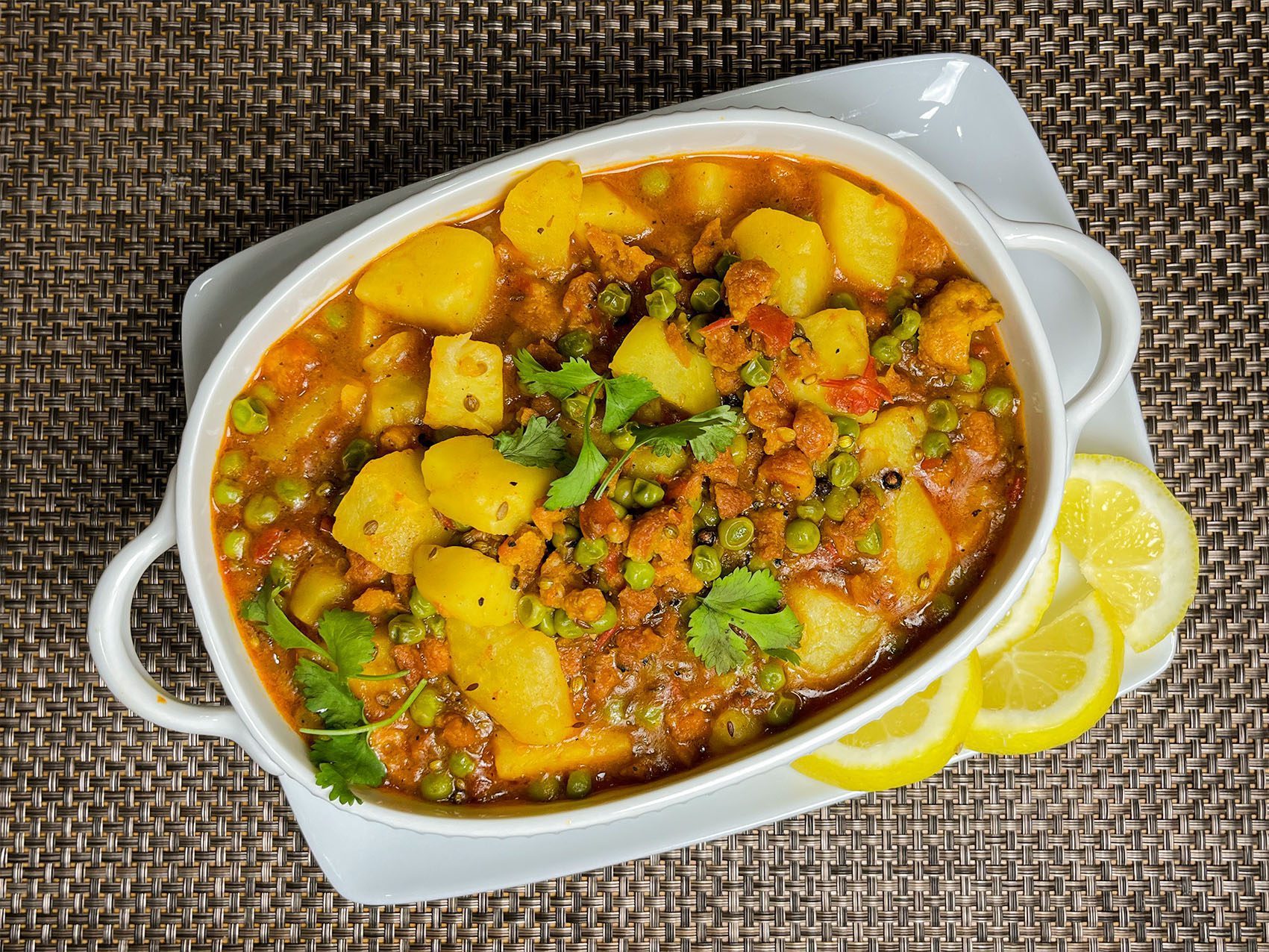
Amritsari Aloo Wadiyan
Aloo Wadi Ki Sabji, Amritsari Punjabi Aloo Vadiyan, Vegan Gluten Free
Amritsari Style Aloo Wadi Ki Sabji has a unique flavor. This is a delightful Punjabi dish using sun-dried lentil dumplings, potatoes and green peas. Aloo Wadi is a spicy, gravy-based dish, perfect for those who enjoy spicy food. Explore this tasty recipe exclusively at Manjula's Kitchen official website.This was one of my favorite dishes growing up. Amritsari Wadi wasn't available at the Indian grocery store where I shop, but they had plain Urad Dal Wadi. I like to use ingredients that are easily available. As usual, I searched on Google for the spices used in Amritsari Wadis, and there were so many different versions that none matched what I remembered. I wanted to make a recipe very close to what I remember.After trying a few times, I finally called my sister to find out the ingredients used in Amritsari Wadi. She knows some good Indian vegetarian recipes that are very traditional and excellent, and of course, she helped me out. After a few tries, I was happy with the balance of spices in the Aloo Wadi.Ingredients
- 2 cups boiled potatoes peeled and cut into byte size cubes
- 1 cup green peas frozen green peas
- 3/4 cup urad dal wadi broken into small pieces
- 3/4 cup tomato puree
- 3 tbsp oil
- 1 tsp cumin seeds (jeera)
- 1/8 tsp asafetida (hing)
- 1-1/2 tbsp coriander crushed (dhania)
- 2 tsp black pepper crushed (kali mirch)
- 2 dry red chilies (sabut lal mirch) broken in small pieces
- 1/4 tsp Kashmiri red chili powder, optional
- 1/4 tsp turmeric (haldi)
- 1-1/2 tsp salt
- 1-1/2 cup water
Instructions
- Heat the pan on medium-low and add 2 tablespoons of oil. Add the urad dal vadi and stir-fry until they are light golden brown, about 2 minute. Remove them and set aside in a bowl.
- In the same saucepan, add the remaining tablespoon of oil over medium heat. When the oil is moderately hot, add the cumin seeds. When the seeds start to crackle, add the asafetida, stir, and then add the tomato puree, coriander, black pepper, red chili, Kashmiri chili powder, turmeric, and salt. Cook, stirring occasionally, until the spice mix starts releasing oil, about 2 minutes.
- Add the potatoes, green peas, vadis, and 1 1/2 cups of water. Cover the pan and let it cook for about 10 minutes over medium-low heat. Adjust the water if needed.
- Vadis are ready, I will serve them with rice.
Notes
About Aloo Wadiyan Punjabi Aloo Wadiyan is a traditional North Indian dish that features potatoes (aloo) and sun-dried Urad Dal dumplings (wadiyan). It’s a flavorful and hearty vegetarian dish that is popular in Punjabi cuisine. The sun-dried lentil dumplings add a unique texture and taste to the dish. If you don’t have urad dal vadiyan, you can use moong dal vadayan.Tried this recipe?Let us know how it was!The Unique Flavor of Amritsari Punjabi Aloo Wadiyan
Amritsari Punjabi Aloo Wadiyan is a delightful and spicy dish from Punjab, known for its unique flavor and the use of sun-dried lentil dumplings (wadiyan). This Aloo Wadi Ki Sabji combines potatoes and green peas with flavorful spices, making it a hearty and satisfying meal. This dish is perfect for those who enjoy a spicy, gravy-based curry, explore more Indian gravy recipes.
The Essence of Aloo Wadi Ki Sabji
The essence of Aloo Wadi Ki Sabji lies in its combination of textures and flavors. The sun-dried urad dal dumplings (wadiyan) add a chewy texture and rich taste, while the potatoes and green peas provide a comforting base. The blend of spices creates a flavorful gravy that ties everything together. This dish is one of the finest Indian vegan recipes that is also gluten-free, making it suitable for various dietary preferences.
Origin and Popularity
Aloo Wadiyan is a traditional dish in Punjabi cuisine, this special occasions recipe often enjoyed during family gatherings. The use of Amritsari wadiyan adds a unique twist to this dish, with the wadiyan being a specialty of the Amritsar region. The combination of potatoes and lentil dumplings in a spicy gravy makes this dish a favorite among those who appreciate hearty and flavorful vegetarian meals.
Why You’ll Love This Recipe
- Unique Flavor: The sun-dried lentil dumplings provide a distinctive taste and texture.
- Spicy and Flavorful: The blend of spices creates a rich and spicy gravy.
- Vegan and Gluten-Free: Suitable for various dietary preferences.
- Comforting and Hearty: Perfect for a satisfying meal, especially when served with rice.
Variations of Vegetable Dry Recipes
Exploring Manjula’s Kitchen reveals a treasure trove of other delicious vegetable dry recipes that you might enjoy. Here are some related dishes that you might find interesting:
- Aloo Gobi: A classic Indian dish made with potatoes and cauliflower cooked with spices.
- Bhindi Masala: A flavorful dish made with okra and a blend of spices.
- Baingan Bharta: A smoky and flavorful dish made with roasted eggplant and spices.
- Gajar Matar: A simple and healthy dish made with carrots and green peas.
- Palak Paneer: A popular dish made with spinach and paneer in a creamy sauce.
Serving Suggestions
Aloo wadi ki sabji can be enjoyed in various ways:
- With Rice: Serve with steamed plain basmati rice or jeera rice for a complete meal.
- With Indian Breads: Pair with roti, naan, or paratha for a satisfying meal.
- As a Side Dish: Enjoy as a side with other Indian curries and dishes.
- For Special Occasions: Perfect for festive meals and family gatherings.
Tips and Tricks
To perfect your aloo wadi ki sabji recipe, consider these helpful tips:
- Use Fresh Wadiyan: Fresh sun-dried lentil dumplings provide the best flavor and texture.
- Balance the Spices: Adjust the spice levels to suit your taste preferences.
- Cook Gently: Simmer the dish on low heat to allow the flavors to meld together.
- Customize: Feel free to add other vegetables like carrots or bell peppers for added nutrition and flavor.
FAQs Frequently Asked Questions
Can I Use Moong Dal Wadiyan Instead of Urad Dal Wadiyan?
Yes, you can use moong dal wadiyan as a substitute if urad dal wadiyan are not available.
How Long Does Aloo Wadi Ki Sabji Last?
Store any leftovers in an airtight container in the refrigerator for up to 2 days. Reheat gently before serving.
Is Aloo Wadi Ki Sabji Vegan?
Yes, this recipe is naturally vegan and gluten-free.
What Can I Serve With Aloo Wadi Ki Sabji?
This dish pairs well with steamed basmati rice, jeera rice, roti, naan, or paratha.
Can I Make This Dish Less Spicy?
Yes, adjust the amount of green chilies and red chili powder to make the dish milder.
-

Roasted Cauliflower with Tomato Gravy
Roasted Cauliflower with Tangy Tomato Gravy
This is simply a delightful indian appetizer or side dish. Cauliflower florets are tossed with yogurt and spices, then shallow-fried. The crispy cauliflower has the perfect bite bursting with flavors, covered in tangy tomato gravy. It makes a mouthwatering appetizer. You can also serve them without tomato gravy, you can choose how spicy you want to make these roasted cauliflower florets. There are so many ways to enjoy this tangy cauliflower dish; they're all delicious!One of my favorite recipe published at Manjula's Kitchen, it can be enjoyed on its own with just a drizzle of oil and with your favorite spices. Some of my favorite dishes with cauliflower, Aloo Gobhi (potato with cauliflower), Pakoras, Paratha, and rice pulav with cauliflower, Gobhi Manchurian.Ingredients
For the Roasted Cauliflower:
- 1 medium cauliflower cut into florets (phool Gobhi), about 18 florates
- 1 cup yogurt
- 2 tbsp corn starch
- 1 tsp cumin seeds (jeera)
- 2 tbsp finely chopped cilantro (dhania)
- 1 tsp finely chopped green chilies optional
- 2 tsp finely shredded ginger
- ½ tsp salt
- 3 tbsp oil for shallow frying
For the Tomato Gravy:
- 2 tbsp oil
- 1 tsp cumin seeds (jeera)
- 2 tsp ginger finely shredded
- 1 cup tomatoes pureed, I used 3 medium size tomatoes
- ¼ tsp turmeric powder
- ½ tsp red chili powder (adjust to taste)
- 2 tsp coriander powder
- 1 tsp garam masala
- 1 tsp salt
- 1 tsp sugar
- 2 tbsp coriander leaves, finely chopped
- ¼ cup chopped tomatoes
For Garnishing:
- 2 green chilies, slit for garnishing
Instructions
- In a large bowl: Mix the yogurt, corn starch, cumin seeds, cilantro, and green chilies until well combined.
- Add the cauliflower florets to the yogurt mixture and toss well to coat each floret evenly.
- Shallow Fry the Cauliflower: Heat oil in a skillet over medium heat, adding just enough to cover the pan.
- Add the cauliflower florets in batches and shallow fry them until they are golden brown and crispy on all sides.
- Remove and drain on paper towels to remove excess oil.
- Tomato Gravy: Mix the corn starch with 1/4 cup of water in a small bowl and set aside.
- Heat oil in a pan over medium heat.
- Add cumin seeds until they crack. Add tomato puree and ginger, stirring for a few seconds.
- Add red chili powder, coriander powder, turmeric, and sauté for another 2-3 minutes until the tomatoes release oil on the sides.
- Add the corn starch paste and cook until the gravy reaches a pourable consistency, adding water if needed.
- Add chopped tomatoes, sugar, garam masala, and cilantro, stir well, and turn off the heat.
- Serve the crispy cauliflower with the tangy tomato gravy and garnish with slit green chilies.
- Enjoy! Roasted cauliflower with tangy tomato sauce.
Notes
For serving: Arrange the cauliflowers on serving plates and pour the tomato sauce and garnish with cilantro and green chilies. serve hot as an appetizer or side dish. Enjoy your Roasted Cauliflower with Tangy Tomato Gravy! Choosing Cauliflower: look for cauliflower with firm and white and firmly attached green leaves. You can store uncut cauliflower in the refrigerator for up to five days How to Cut & Prepare Cauliflower: To separate the cauliflower florets from the core, halve and then quarter the head. This exposes the core, making it easy to cut out the florets. Health Benefits of Cauliflower: Cauliflower is full of dietary fiber, vitamin C, and folic acid. Cauliflower is great for digestion and iron absorption as well. It’s a total vegetable all-star and helps round out a healthy meal!Tried this recipe?Let us know how it was!How to Make Roasted Cauliflower in Tangy Tomato Gravy: A Healthy and Flavorful Curry Recipe
Roasted Cauliflower with Tangy Tomato Gravy is a flavorful and nutritious dish that combines the earthy taste of roasted cauliflower with a tangy, spiced tomato gravy. This cauliflower tomato curry is perfect for those looking to enjoy a healthy delicious meal, this simple indian vegetarian recipe is easy to prepare and packed with flavor. Whether served with plain indian rice or flatbread, this dish is sure to become a favorite in your household.
The Essence of Roasted Cauliflower with Tangy Tomato Gravy
The essence of this dish lies in its balance of flavors and textures. The cauliflower is roasted to perfection, bringing out its natural sweetness and adding a delightful crunch can be served with Indian main course recipes. The tangy tomato gravy is made with ripe tomatoes and a blend of aromatic spices, creating a rich and flavorful sauce that complements the roasted cauliflower beautifully.
Origin and Popularity
Cauliflower is a versatile vegetable used in various cuisines around the world. Roasting cauliflower enhances its flavor and texture, making it a popular method of preparation. This roasted cauliflower recipe with tangy tomato gravy draws inspiration from Indian cuisine, where tomato-based gravies are commonly used to create rich, flavorful dishes.
Why You’ll Love This Recipe
- Flavorful and Nutritious: Combines the goodness of roasted cauliflower with a tangy, spiced tomato gravy.
- Easy to Make: Simple ingredients and straightforward steps make this recipe accessible to everyone.
- Versatile: Can be served with rice, flatbread, or as a standalone dish.
- Perfect for Any Occasion: Ideal for everyday meals or special gatherings.
How to Make Roasted Cauliflower with Tangy Tomato Gravy
To make this delightful roasted cauliflower with tangy tomato gravy, start by mixing yogurt, corn starch, cumin seeds, cilantro, and green chilies in a large bowl. Coat cauliflower florets in this mixture. Heat oil in a skillet over medium heat and shallow fry the florets until golden brown and crispy. Drain excess oil using paper towels.
For the tomato gravy, mix corn starch with 1/4 cup water. Heat oil in a pan, add cumin seeds, and once they crackle, add tomato puree and ginger. Stir in red chili powder, coriander powder, turmeric, and sauté for 2-3 minutes until the tomatoes release oil. Add the corn starch paste and cook until the gravy is of pourable consistency, adding water if needed. Stir in chopped tomatoes, sugar, garam masala, and cilantro, then turn off the heat.
Serve the crispy cauliflower florets with the tangy tomato gravy, garnished with slit green chilies. This dish is very good indian appetizer or can be served hot as an side dish, garnished with cilantro and green chilies.
When choosing cauliflower, look for firm, white heads with firmly attached green leaves. Store uncut cauliflower in the refrigerator for up to five days. Cauliflower is rich in dietary fiber, vitamin C, and folic acid, promoting digestion and iron absorption, making it a nutritious addition to any meal. Enjoy!
Variations of Cauliflower Dishes
Exploring Manjula’s Kitchen reveals a treasure trove of other delicious cauliflower recipes that you might enjoy. Here are some related dishes that you might find interesting:
- Aloo Gobi: A classic Indian dish made with potatoes and cauliflower cooked with spices.
- Baked Cauliflower: Cauliflower Spinach Bake is a healthy indian recipe which is nutrition-rich side dish that is easy and quick to make.
- Cauliflower Manchurian: An Indo-Chinese dish featuring crispy cauliflower florets in a tangy sauce.
- Cauliflower Crust Pizza: This is a yummy and healthy cauliflower crusted pizza, made with fresh ingredients and also egg-less. Pizza sauce and Indian cheese was made from scratch using fresh ingredients. Its a nice appetizer..
- Gobi Paratha: A stuffed flatbread or gobi paratha with a spicy cauliflower filling.
Serving Suggestions
Roasted cauliflower with tangy tomato gravy can be enjoyed in various ways:
- With Rice: Serve it with steamed basmati rice or jeera rice for a complete meal.
- With Flatbread: Pair it with naan, roti, or paratha for a satisfying lunch or dinner.
- As a Side Dish: Serve it alongside other Indian vegetarian recipes for a flavorful spread.
- On Its Own: Enjoy it as a standalone dish for a light and healthy meal.
Tips and Tricks
To perfect your roasted cauliflower with tangy tomato gravy recipe, consider these helpful tips:
- Roast Evenly: Ensure the cauliflower florets are evenly coated with oil and spread out on the baking sheet for even roasting.
- Use Fresh Tomatoes: Fresh, ripe tomatoes provide the best flavor for the gravy.
- Adjust Spices: Tailor the amount of spices to suit your taste preference.
- Simmer Slowly: Let the gravy simmer slowly to develop a rich and deep flavor.
FAQs
Can I Use Frozen Cauliflower?
Yes, you can use frozen cauliflower. Thaw it and pat it dry before roasting to prevent excess moisture.
How Long Does This Dish Last?
Store any leftovers in an airtight container in the refrigerator for up to 3 days. Reheat before serving.
Is This Recipe Vegan?
Yes, this recipe is naturally vegan and gluten-free.
Can I Add Other Vegetables?
Absolutely, you can add other vegetables like bell peppers, peas, or carrots to the dish.
What If I Don’t Have Fresh Tomatoes?
You can use canned tomatoes or tomato puree as a substitute for fresh tomatoes.
-
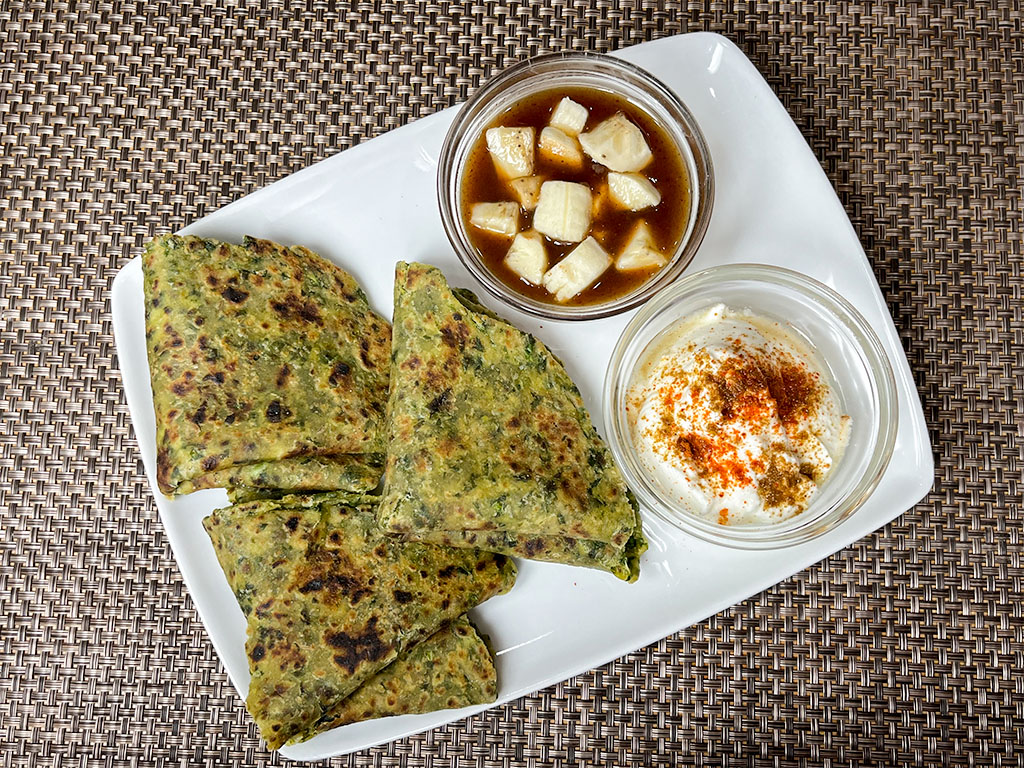
Spinach Almond Paratha
Spinach Almond Paratha
Spinach Almond Paratha is a delicious unleavened Indian flatbread made on a skillet. There are many variations of parathas, most of which are made with whole wheat flour. Parathas can be plain or stuffed with various fillings.Spinach Almond Paratha is a healthy indian recipe and tasty option. It is crispy on the outside and soft on the inside. This paratha is made with spinach, almond flour, whole wheat flour, and some spices. It can be served for indian breakfast recipe with butter, yogurt, or pickle, or as part of a meal alongside toor dal or a gravy-based dish.Almond Spinach Paratha has a beautiful green color and is a nutritious alternative, especially great for incorporating spinach into your diet.When making indian parathas, it's important to know how to roll and fold them. While rolling the dough, apply oil or ghee and fold it to create layers. This technique results in parathas that are crisp on the outside and have a soft texture inside.Another advantage of parathas is that they keep well, making them perfect for lunch boxes or for picnics.Ingredients
- 1 cup whole wheat flour, atta
- ½ cup almond flour – badam ka powder
- 1½ cup chopped spinach, Palak
- 1 tbspn oil
- 1 tsp cumin seeds, jeera
- ½ tsp salt
- ¼ tsp black pepper, kali mirch
- ⅛ tsp asafetida, hing
- ½ cup chilled water
- ½ tsp red chili flake if you like hot and spicy
- ¼ cup whole wheat flour for rolling paratha
- 2 tbsp oil for cooking parathas
Instructions
- Mix all the ingredients together in a bowl, except water: flour, almond flour, chopped spinach, salt, black pepper, cumin seeds, asafetida, and oil. Add water as needed to make a firm dough (as it sits dough will get soft). Grease your palm and knead the dough until all the ingredients are combined. Let the dough sit aside for about 15 minutes.
- Knead the dough on a lightly greased surface until it becomes soft. Divide the dough into four equal parts and form them into balls. Roll each dough ball into a 3-inch circle. Spread about 2 drops of oil on each circle and fold them into triangles. Repeat this process for all four triangles.
- Meanwhile, heat a heavy skillet on medium heat until moderately hot. To test if the skillet is ready, sprinkle a few drops of water on it. When the water sizzles right away, the skillet is ready.
- Take one dough ball and lightly press it on both sides on a surface dusted with dry flour. Using a rolling pin, roll the dough into a 7–8-inch circle. If the dough starts sticking, dust it with more flour.
- Place the paratha on the skillet. When you see the color change and the paratha puffs up in different places, turn the paratha over. After a few seconds, spread 1/2 teaspoon of oil onto the paratha. Turn the paratha over again and spread another 1/2 teaspoon of oil. Using your spatula, lightly press the entire surface of the paratha to help it cook all the way through.
- After a few seconds, flip the paratha and press with the spatula, ensuring it is golden-brown on both sides. Repeat this process for the remaining parathas.
- For the best taste serve paratha hot, taste great with hot cup of Chai. Enjoy!
Notes
When making parathas, it’s important to know how to roll and fold them. While rolling the dough, apply oil or ghee and fold it to create layers. This technique results in parathas that are crisp on the outside and have a soft texture inside.
Spinach Almond paratha taste great when cooked with ghee, (clarified butter).
Serving suggestions:
For breakfast serve the Spinach Almond Paratha with yogurt and pickle, or as part of a meal alongside dal or a gravy-based dish.Tried this recipe?Let us know how it was!Introduction
Spinach Almond Paratha is a nutritious and flavorful Indian flatbread that combines the goodness of spinach and the crunch of almonds. This spinach almond paratha recipe is perfect for a healthy indian recipes breakfast, lunch, or indian dinner recipes. The addition of spinach not only enhances the nutritional value but also adds a vibrant green color, while the almonds provide a delightful crunch and a boost of healthy fats and proteins.
The Essence of Spinach Almond Paratha
The essence of spinach almond paratha lies in its blend of fresh spinach and finely chopped almonds. The spinach is mixed into the dough, making each bite packed with nutrients and flavor. The almonds add a unique texture and richness, making this paratha a wholesome and satisfying meal.
Origin and Popularity
Parathas are a staple in Indian cuisine, particularly in North India. They are enjoyed in various forms, stuffed with different fillings or mixed with ingredients like spinach and almonds. This healthy paratha recipe is a modern twist on the traditional paratha, incorporating superfoods to make it even more nutritious and delicious.
Why You’ll Love This Recipe
- Nutritious and Delicious: Packed with vitamins, minerals, and healthy fats from spinach and almonds.
- Easy to Make: Simple ingredients and straightforward steps make this recipe accessible to everyone.
- Versatile: Can be enjoyed as a main dish, side dish, or even as a snack.
- Perfect for Any Meal: Ideal for breakfast, lunch, or dinner.
How to Make Spinach Almond Paratha: Here’s a step-by-step guide on how to make spinach almond paratha:
- Prepare the Ingredients:
- Fresh spinach, washed and finely chopped.
- Almonds, finely chopped or ground.
- Whole wheat flour, water, and salt for the dough.
- Optional spices: cumin powder, garam masala, and green chilies for extra flavor.
- Make the Dough:
- In a large mixing bowl, combine whole wheat flour, chopped spinach, and almonds.
- Add salt and any optional spices.
- Gradually add water and knead the mixture into a soft dough.
- Cover the dough and let it rest for 15-20 minutes.
- Roll Out the Parathas:
- Divide the dough into equal-sized balls.
- Roll each ball into a flat circle using a rolling pin, dusting with flour as needed to prevent sticking.
- Cook the Parathas:
- Heat a tawa or skillet over medium heat.
- Place a rolled-out paratha on the hot tawa and cook until bubbles start to form.
- Flip the paratha and cook the other side until golden brown spots appear.
- Apply a small amount of oil or ghee on both sides and cook until crispy and fully cooked.
- Serve Hot:
- Serve the spinach almond parathas hot with yogurt, pickles, or your favorite curry.
Variations of Parathas
Exploring Manjula’s Kitchen reveals a treasure trove of other delicious paratha recipes that you might enjoy. Here are some related parathas that you might find interesting:
- Aloo Paratha: A classic stuffed paratha with a spiced potato filling.
- Paneer Paratha: Paratha stuffed with a flavorful paneer (Indian cottage cheese) filling.
- Methi Paratha: A healthy paratha made with fresh fenugreek leaves.
- Gobhi Paratha: Paratha stuffed with a spiced cauliflower filling.
- Palak Paratha: Another spinach-based paratha, perfect for a nutritious meal.
Serving Suggestions
Spinach almond paratha can be enjoyed in various ways:
- With Yogurt: Serve with plain or flavored yogurt for a cooling side.
- With Pickles: Pair with Indian pickles for a tangy contrast.
- With Raita: Serve with a refreshing cucumber or mint raita.
- As a Wrap: Use the paratha as a base for wraps, adding vegetables or paneer.
- With Curries: Enjoy with your favorite vegetarian curry.
Tips and Tricks
To perfect your spinach almond paratha recipe, consider these helpful tips:
Use Fresh Ingredients: Fresh spinach and high-quality almonds enhance the flavor.
Knead Well: Ensure the dough is well-kneaded for a soft and pliable texture.
Rest the Dough: Letting the dough rest helps it become more elastic and easier to roll out.
Cook on Medium Heat: Cooking on medium heat ensures the paratha is cooked through without burning.
Customize Spices: Adjust the spices to suit your taste preferences.
FAQs
Can I Use Frozen Spinach?
Yes, you can use frozen spinach. Thaw and drain it well before adding to the dough.
How Long Does Spinach Almond Paratha Last?
Parathas are best enjoyed fresh but can be stored in the refrigerator for up to 2 days. Reheat on a tawa before serving.
Can I Freeze the Dough?
Yes, you can freeze the dough for up to a month. Thaw it in the refrigerator before using.
Is This Recipe Vegan?
To make this recipe vegan, use oil instead of ghee for cooking the parathas.
Can I Add Other Ingredients?
Feel free to add other ingredients like grated carrots, beetroot, or different nuts for variety.

